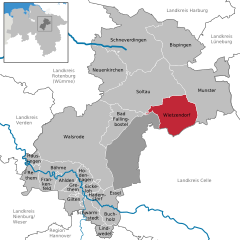| Wietzendorf | |
|---|---|
| Municipality | |
 Saint James' church Saint James' church | |
 Flag Flag Coat of arms Coat of arms | |
Location of Wietzendorf within Heidekreis district
 | |
  | |
| Coordinates: 52°55′07″N 9°58′37″E / 52.91861°N 9.97694°E / 52.91861; 9.97694 | |
| Country | Germany |
| State | Lower Saxony |
| District | Heidekreis |
| Government | |
| • Mayor (2019–24) | Jörg Peters |
| Area | |
| • Total | 106.88 km (41.27 sq mi) |
| Elevation | 66 m (217 ft) |
| Population | |
| • Total | 4,169 |
| • Density | 39/km (100/sq mi) |
| Time zone | UTC+01:00 (CET) |
| • Summer (DST) | UTC+02:00 (CEST) |
| Postal codes | 29649 |
| Dialling codes | 05196 |
| Vehicle registration | HK |
| Website | www.wietzendorf.de |
Wietzendorf (Eastphalian: Witzendörp) is a municipality in the district of Heidekreis, in Lower Saxony, in northern Germany. It is situated approximately 14 km southeast of Soltau, and 50 km southwest of Lüneburg. The population as of 31 December 2012 is 4,071 people.
World War II
During World War II, a camp for prisoners of war (Kriegsgefangenenlager), including a section for officers (Oflag 83), was located near Wietzendorf. The camp was initially used for Soviet prisoners from the Eastern Front; later it was partially evacuated because of the poor sanitary conditions and used to house other prisoners, including many Italian Military Internees which Nazi Germany considered to have lost their military status, as they had declined to follow Mussolini's orders after the armistice between Italy and the Allies. Among the Italian prisoners was Giovannino Guareschi, who would later become world-renowned as the author of Don Camillo and Alessandro Natta, later General Secretary of the PCI. The present day district of Lührsbockel was the location of a forced labour subcamp of the prison in Celle.
In 1968 also Polish POWs from World War II were buried there.
Gallery
References
- "Verzeichnis der direkt gewählten Bürgermeister/-innen und Landräte/Landrätinnen". Landesamt für Statistik Niedersachsen. April 2021.
- "LSN-Online Regionaldatenbank, Tabelle A100001G: Fortschreibung des Bevölkerungsstandes, Stand 31. Dezember 2022" (in German). Landesamt für Statistik Niedersachsen.
- "Rapporto sul Campo 83 Wietzendorf" (PDF). Storia XXI Secolo. Ten.Col Pietro Testa. Retrieved 11 April 2016.
- "Adriano Pasquetto: storia di un Internato Militare Italiano. La prigionia a Leopoli e Wietzendorf". Restelli Storia. Prof. Giancarlo Restelli. Retrieved 11 April 2016.
- "La storia di Giovannino senza paura (1943-1945)". Giovannino Guareschi. Retrieved 11 April 2016.
Dall'OFLAG X B di Sandbostel (D) a piedi alla stazione di Bremerwörde (D) il 29 gennaio 1945 e riparte il 30 per l'OFLAG 83 di Wietzendorf (D) dove arriva il 31 Viene liberato il 16 aprile .
- "Außenkommando des Zuchthauses Celle in Lührsbockel". Bundesarchiv.de (in German). Retrieved 8 November 2023.
External links
 Media related to Wietzendorf at Wikimedia Commons
Media related to Wietzendorf at Wikimedia Commons
| Towns and municipalities in Heidekreis | ||
|---|---|---|




